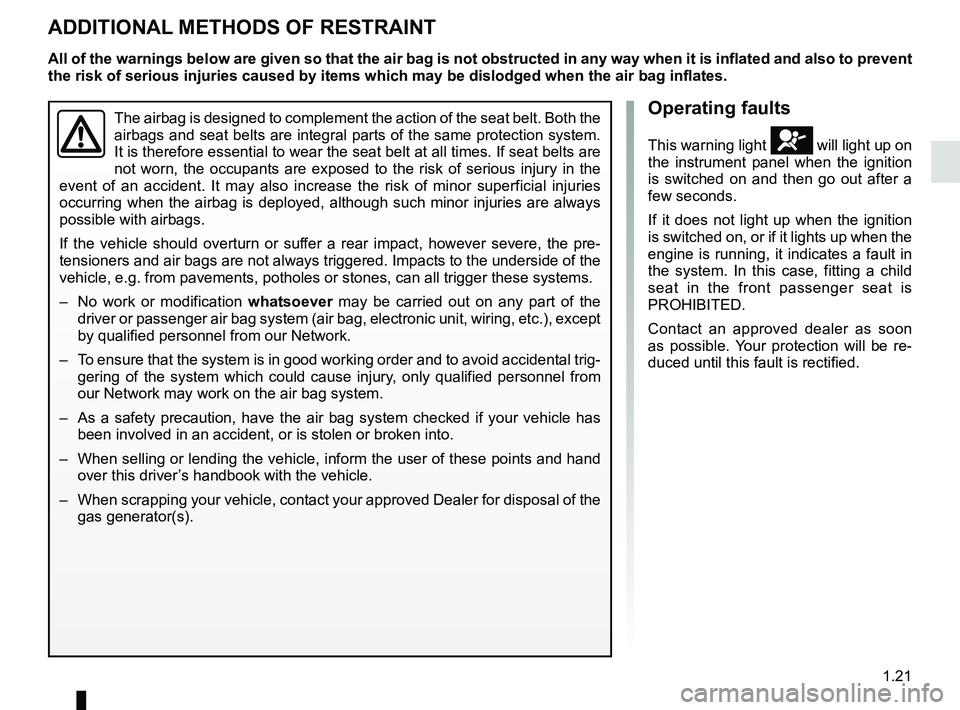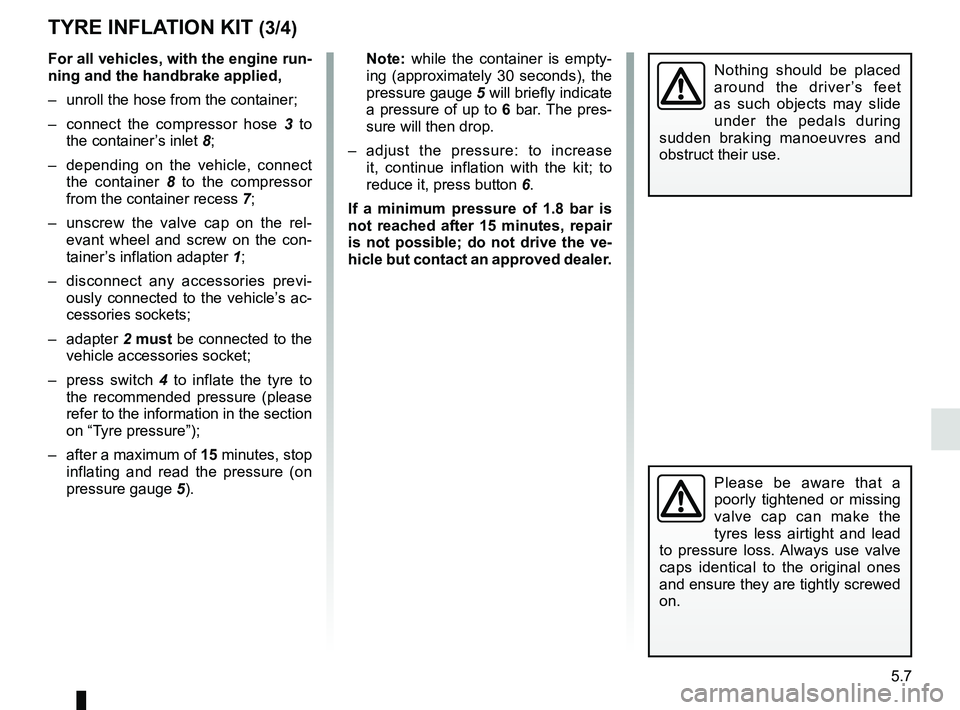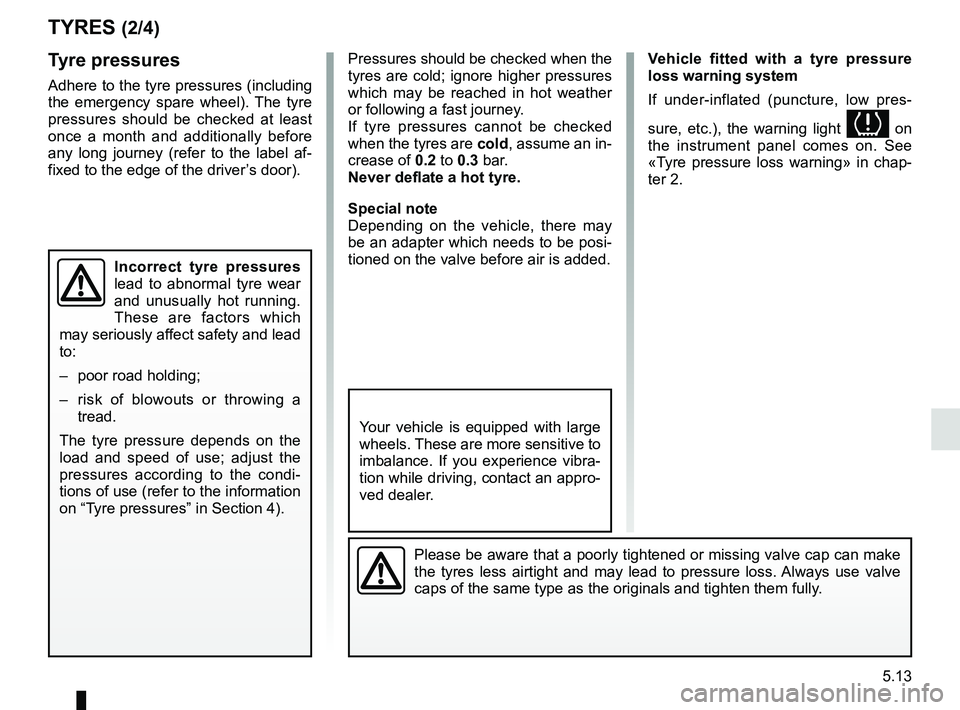run flat RENAULT DUSTER 2016 Owners Manual
[x] Cancel search | Manufacturer: RENAULT, Model Year: 2016, Model line: DUSTER, Model: RENAULT DUSTER 2016Pages: 256, PDF Size: 6.49 MB
Page 27 of 256

1.21
The airbag is designed to complement the action of the seat belt. Both t\
he
airbags and seat belts are integral parts of the same protection system.\
It is therefore essential to wear the seat belt at all times. If seat be\
lts are
not worn, the occupants are exposed to the risk of serious injury in the\
event of an accident. It may also increase the risk of minor superficial\
injuries
occurring when the airbag is deployed, although such minor injuries are \
always
possible with airbags.
If the vehicle should overturn or suffer a rear impact, however severe, the pre-
tensioners and air bags are not always triggered. Impacts to the undersi\
de of the
vehicle, e.g. from pavements, potholes or stones, can all trigger these \
systems.
– No work or modification whatsoever may be carried out on any part of the
driver or passenger air bag system (air bag, electronic unit, wiring, e\
tc.), except
by qualified personnel from our Network.
– To ensure that the system is in good working order and to avoid accidenta\
l trig- gering of the system which could cause injury, only qualified personnel from
our Network may work on the air bag system.
– As a safety precaution, have the air bag system checked if your vehicle \
has been involved in an accident, or is stolen or broken into.
– When selling or lending the vehicle, inform the user of these points and\
hand over this driver’s handbook with the vehicle.
– When scrapping your vehicle, contact your approved Dealer for disposal o\
f the gas generator(s).
All of the warnings below are given so that the air bag is not obstructe\
d in any way when it is inflated and also to prevent
the risk of serious injuries caused by items which may be dislodged when\
the air bag inflates.
ADDITIONAL METHODS OF RESTRAINT
Operating faults
This warning light å will light up on
the instrument panel when the ignition
is switched on and then go out after a
few seconds.
If it does not light up when the ignition
is switched on, or if it lights up when the
engine is running, it indicates a fault in
the system. In this case, fitting a child
seat in the front passenger seat is
PROHIBITED.
Contact an approved dealer as soon
as possible. Your protection will be re-
duced until this fault is rectified.
Page 185 of 256

5.7
For all vehicles, with the engine run-
ning and the handbrake applied,
– unroll the hose from the container;
– connect the compressor hose 3 to
the container’s inlet 8;
– depending on the vehicle, connect the container 8 to the compressor
from the container recess 7;
– unscrew the valve cap on the rel- evant wheel and screw on the con-
tainer’s inflation adapter 1;
– disconnect any accessories previ- ously connected to the vehicle’s ac-
cessories sockets;
– adapter 2 must be connected to the
vehicle accessories socket;
– press switch 4 to inflate the tyre to
the recommended pressure (please
refer to the information in the section
on “Tyre pressure”);
– after a maximum of 15 minutes, stop inflating and read the pressure (on
pressure gauge 5). Note: while the container is empty-
ing (approximately 30 seconds), the
pressure gauge
5 will briefly indicate
a pressure of up to 6 bar. The pres-
sure will then drop.
– adjust the pressure: to increase it, continue inflation with the kit; to
reduce it, press button 6.
If a minimum pressure of 1.8 bar is
not reached after 15 minutes, repair
is not possible; do not drive the ve-
hicle but contact an approved dealer.Nothing should be placed
around the driver’s feet
as such objects may slide
under the pedals during
sudden braking manoeuvres and
obstruct their use.
Please be aware that a
poorly tightened or missing
valve cap can make the
tyres less airtight and lead
to pressure loss. Always use valve
caps identical to the original ones
and ensure they are tightly screwed
on.
TYRE INFLATION KIT (3/4)
Page 191 of 256

5.13
TYRES (2/4)
Tyre pressures
Adhere to the tyre pressures (including
the emergency spare wheel). The tyre
pressures should be checked at least
once a month and additionally before
any long journey (refer to the label af-
fixed to the edge of the driver’s door).
Incorrect tyre pressures
lead to abnormal tyre wear
and unusually hot running.
These are factors which
may seriously affect safety and lead
to:
– poor road holding;
– risk of blowouts or throwing a tread.
The tyre pressure depends on the
load and speed of use; adjust the
pressures according to the condi-
tions of use (refer to the information
on “Tyre pressures” in Section 4).
Please be aware that a poorly tightened or missing valve cap can make
the tyres less airtight and may lead to pressure loss. Always use valve
caps of the same type as the originals and tighten them fully.
Pressures should be checked when the
tyres are cold; ignore higher pressures
which may be reached in hot weather
or following a fast journey.
If tyre pressures cannot be checked
when the tyres are cold, assume an in-
crease of 0.2 to 0.3 bar.
Never deflate a hot tyre.
Special note
Depending on the vehicle, there may
be an adapter which needs to be posi-
tioned on the valve before air is added.
Your vehicle is equipped with large
wheels. These are more sensitive to
imbalance. If you experience vibra-
tion while driving, contact an appro-
ved dealer.
Vehicle fitted with a tyre pressure
loss warning system
If under-inflated (puncture, low pres-
sure, etc.), the warning light
on
the instrument panel comes on. See
«Tyre pressure loss warning» in chap-
ter 2.
Page 252 of 256

7.4
ALPHABETICAL INDEX (4/5)
remote control door lockingbatteries ..............................................................\
......... 5.38
remote control door locking unit ................................1.2 → 1.4
remote engine start-up ............................................... 1.2 – 1.3
RENAULT ANTI-INTRUDER DEVICE (RAID) ..................... 1.7
replacement parts ................................................................ 6.8
reverse gear selecting ..............................................................\
......... 2.29
reversing sensor ..................................................... 2.49 – 2.50
roof bars ........................................................................\
.... 3.28
roof rack roof bars ....................................................................... 3.28
running in ........................................................................\
..... 2.2
S
seat belts ...............................................................1.13 → 1.21
service sheets..........................................................\
6.9 → 6.14
signals and lights .................................................... 1.59 – 1.60
speakers location ...............................................................\
......... 5.43
special features of diesel versions.....................................\
2.11
special features of LPG versions ..... 2.12 → 2.14, 5.28 → 5.35
special features of petrol vehicles ..................................... 2.10
speed limiter ..........................................................2.38 → 2.40
starting ...............................................................\
........2.3 → 2.6
starting the engine .....................................................2.2 → 2.9
steering wheel adjustment .............................................................\
...... 1.56
Stop & Start ...............................................................2.7 → 2.9
Stop & Start function..................................................2.7 → 2.9
storage compartment.............................................3.16 → 3.19
storage compartments ...........................................3.16 → 3.19
sun visor ........................................................................\
.... 3.13
T
tailgate ...............................................................\
....3.23 → 3.25tanks and reservoirs
brake fluid ...................................................................... 4.8
coolant ................................................................\
........... 4.9
tanks and reservoirs: windscreen washer ...................................................... 4.10
technical specifications .......................................6.2, 6.6 → 6.8
telephone ..............................................................\
............. 3.29
towing .................................................................\
................. 6.7 breakdown .......................................................5.40 → 5.42
towing equipment ......................................................... 3.26
towing a caravan ................................................................. 6.7
towing hitch............................................................\
5.40 → 5.42
towing rings ............................................................ 3.24 – 3.25
towing weights ..................................................................... 6.7
traction control .......................................................2.34 → 2.37
transporting children ..............................................1.22 → 1.32
transporting objects in the luggage compartment ............................. 3.24 – 3.25
trims ..................................................................\
................... 5.9
trip computer and warning system.........................1.50 → 1.55
tyre inflation kit......................................................\
.....5.5 → 5.8
tyre pressure.............................2.22 → 2.28, 4.12 – 4.13, 5.13
tyre pressure loss warning.....................................2.22 → 2.28
tyre pressures ......................................................... 4.12 – 4.13
tyres ............................. 2.22 → 2.28, 4.12 – 4.13, 5.12 → 5.15
V
variable power-assisted steering ....................................... 1.56
vehicle identification ............................................................ 6.2
vehicle identification plates ........................................6.2 → 6.4
ventilation air conditioning ...................................................... 3.2 – 3.3
heating and air conditioning system ....................3.4 → 3.7
W
warning buzzer .................................................................. 1.60